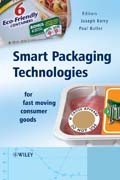
Smart packaging technologies for fast moving consumer goods
Kerry, Joseph
Butler, Paul
Smart Packaging Technologies for Fast Moving Consumer Goods documents the latest developments and applications of smart packaging technologies for the fastmoving consumer goods (FMCG) market. The focus of this reference is primarilyfood and beverages, but other FMCGs such as household cleaners and health andbeauty products are also included. Each chapter starts with a definition of the technology, and proceeds with an analysis of its workings and components before concluding with snapshots of potential applications of the technology. INDICE: Preface 1 Active Packaging of Food 1.1 Introduction and BackgroundInformation 1.2 Oxygen Scavengers 1.3 Carbon Dioxide Scavengers/Emitters 1.4 Ethylene Scavengers 1.5 Ethanol Emitters 1.6 Preservative Releasers 1.7 Moisture Absorbers 1.8 Flavour/Odour Absorbers and Releasers 1.9 Temperature ControlPackaging 1.10 Temperature Compensating Films 1.11 Conclusions 1.12 References 2 Active Polymer Packaging of Non-Meat Food Products 2.1 Introduction 2.2 Bread and Bakery Products 2.3 Fruits and Vegetables 2.4 Dairy Products 2.5 Fish and Seafood 2.6 Outlook and Future Developments 2. 7 Acknowledgements 2.8 References 3 Smart Packaging of Meat and Poultry Products 3.1 Introduction 3.2 Oxygen Scavengers 3.3 Carbon Dioxide Scavengers and Emitters 3.4 Moisture Control3.5 Antimicrobial Packaging 3.6 Sensors 3.7 Indicators 3.8 Radio Frequency Identification 3.9 Potential Future Applications for Smart Packaging with Meat Products 3.10 References 4 Application of Time Temperature Integrators for Monitoring and Management of Perishable Product Quality in the Cold Chain 4.1 Introduction 4.2 Time-Temperature Integrators 4.3 Cold Chain Management 4.4 Acknowledgements 4.5 References 5 Smart Packaging Technologies for Fish and Seafood Products 5.1 Introduction 5.2 What Are the Parameters of Fish Quality? 5.3 Mechanisms of Fish Spoilage 5.4 On-Pack Quality Indicators 5.5 Time-Temperature Integrators 5.6 Food Quality Indicators 5.7 Overview: TTI versus FQI 5.8 Modified Atmosphere Packaging (MAP) 5.9 Conclusion 5.10 Acknowledgements 5.11 References 6 Antimicrobial Packaging for Food 6.1 Background of Antimicrobial Packaging Systems for Food 6.2 Governmental Encouragement 6.3 Demand for Antimicrobial and Disinfectant Chemicals in the U.S Market 6.4 History of Antimicrobial Packaging in Industry 6.5 Antimicrobial Agents in Use for Commercialization 6.6Mechanism of Antimicrobial Packaging Systems 6.7 Design of Antimicrobial Packaging Systems 6.8 Prognosis for Commercialization 6.9 The future of Antimicrobial Packaging Systems 6.10 References 7 Freshness Indicators for Food Packaging 7.1 Introduction 7.2 Freshness Indicators for Quality Indicating Metabolites7.2.1 Metabolites Related to Glucose Fermentation 7.3 Volatile Nitrogen Compounds 7.4 Biogenic Amines 7.5 Carbon Dioxide 7.6 Other Quality Indicators for Microbial Spoilage and Contamination 7.7 References 8 An Active Moisture-Management Packaging System for Food and Other Products: A Case Study 8.1 Introduction 8.2 Principles of Moisture-Management and Water Activity 8.3 Moisture Sorption Isotherm 8.4 An Active Moisture-Management System 8.4.1 Application to Beef Jerky 8.4.2 Humidity Restoration in Beef Jerky 8.5 Mold Inhibition 8.6 Printing Potassium Sorbate 8.7 Packaging Executions 8.8 Marketplace Executions and Testing 8.9 Beef Jerky 8.10 Dried Fruit 8.11 Musical Instruments Made of Wood 8.12 Works of Art 8.13 Nylon Parts 8.14 Clothing Storage in Humid Environments8.15 Competitive Technology 8.16 Future Trends 8.17 References 9 Smart Packaging Technologies for Fruits and Vegetables 9.1 Introduction 9.2 Packaging Requirements for Fruits and Vegetables 9.3 Time-Temperature Indicators 9.4 Breathable Materials 9.5 Gas and Volatiles Indicators 9.6 RFID in the Fresh and Minimally Processed Fruits and Vegetable< 9.7 References 10 The Influence of Product and Packaging Characteristics on Passive RFID Readability 10.1 Introduction 10.2 What Is Packaging? 10.3 Discussion of Specific Packaging Materials 10.4 The Infuence of Product and Packaging Materials on RFID 10.5 The Influence of Packaging System Characteristics on RFID 10.6 Chapter Summary 10.7 References 11 How Marks Self-Heating Drivers Biometrics for Brand Protection of Goods and Packaging 16.1 Introduction 16.2 Naturally Occurring Randomness 16.3 Diffuse Laser Scattering 16.4 The Statistics of LSA 16.5 The Practicalities of Using LSA 16.6 Applications and Advantages of LSA Smart Packaging Legislation 17 Legislative Issues Relating to Smart Packaging 17.1 Introduction 17.2 Smart Packaging 17.3 Legislation Relevant to Smart Packaging 17.4 Demonstration of Compliance of Active and Intelligent Packaging 17.4.1 Basic Rules for Migration Testing 17.4.2 Active and Intelligent Packaging 17.5 Conclusions 17.6 References
- ISBN: 978-0-470-02802-5
- Editorial: John Wiley & Sons
- Encuadernacion: Cartoné
- Páginas: 344
- Fecha Publicación: 11/04/2008
- Nº Volúmenes: 1
- Idioma: Inglés
